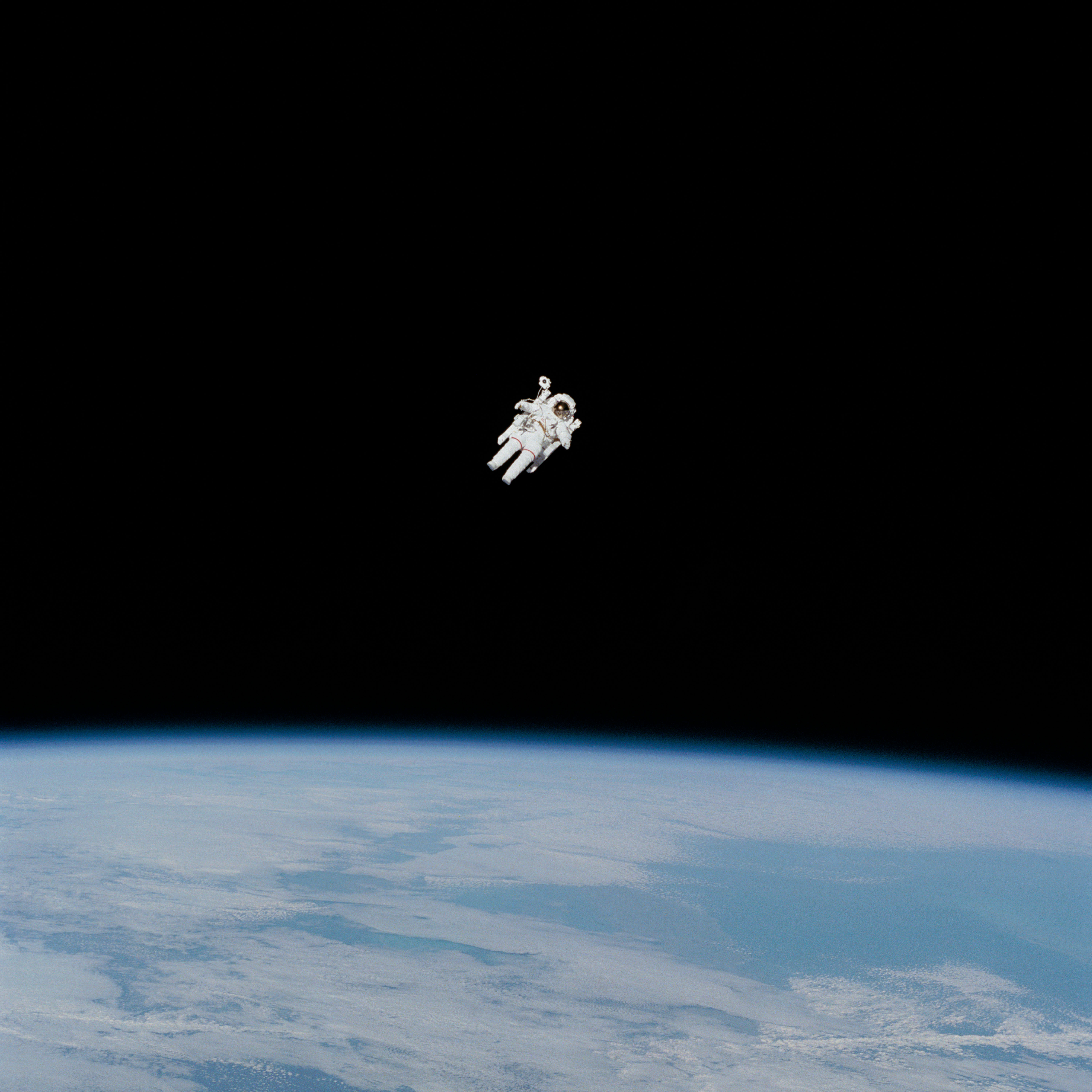Planetarium, and a brief history of space music
How the new album by Sufjan Stevens, Nico Muhley, Bryce Dressner, and James McAlister builds on 2,000 years of galactic compositions


For as long as people have been looking up at the planets, we've been trying to fill them: with gods, with Martians, but especially with sound.
The latest attempt at the latter, out this Friday, is the song-cycle Planetarium by Sufjan Stevens, composer Nico Muhley, The National's Bryce Dressner, and percussionist James McAlister. Featuring a string quartet and seven trombones, the album is dense and galactic in its ambitions, but also magnificently human despite its upward-focused themes. The 17 tracks, which range from 30 seconds to 15 minutes, parade a range of musical styles keyed into the "mood" of each subject, from the classically influenced "Earth" to the house-beat-bopping "Saturn." For all four musicians involved, Planetarium marks an unequivocal highlight of their careers.
Strictly speaking, Planetarium is not a new project; its earliest iteration dates back to 2012, when a Dutch concert hall commissioned Muhly to write new music. Muhly roped in his friends, Dressner and Stevens, and Stevens brought with him his longtime collaborator, McAlister, who worked on the percussion and electronic sequencing on the album.
The Week
Escape your echo chamber. Get the facts behind the news, plus analysis from multiple perspectives.

Sign up for The Week's Free Newsletters
From our morning news briefing to a weekly Good News Newsletter, get the best of The Week delivered directly to your inbox.
From our morning news briefing to a weekly Good News Newsletter, get the best of The Week delivered directly to your inbox.
To the joy of anyone who has spent the last half decade listening to Planetarium via terrible cellphone videos on YouTube, Friday's release is an expanded studio version of that project. In addition to compositions for each of the nine planets (Pluto is included "out of pity"), the album features songs for "Halley's Comet," "Black Energy," "Tides," and "Black Hole." With all the rearrangements and additions, Planetarium now runs about 15 minutes longer than the original hour-long suite.
Yet despite the number of its contributors, there is something about Planetarium that is devastatingly lonely. It touches on a fear that man has spent centuries grappling with when looking up at the stars: Is there anybody else out there?
And in that question, a cataclysmic possibility: What if there's not?

When reflecting on the origin of Planetarium to Billboard, Muhly noted that "with [ancient] Greek and Roman religions, there's an active connection between observing something and making art about it. Naming stars is a weird combination of the scientific and poetic." In fact, the plaits of music and the cosmos wind back more than 2,000 years, to the triangle-loving Greek philosopher and mathematician Pythagoras. Among his most influential theories, Pythagoras described the "music of the spheres," a celestial, philosophical symphony in which the sun, moon, and planets influence the goings-on of Earth with their inaudible hums — a kind of mathematical balance not so unlike the relation between the length of a string and the depth of the note it produces, another of Pythagoras' discoveries.
A free daily email with the biggest news stories of the day – and the best features from TheWeek.com
In addition to giving the heavenly bodies their names, then, the Greeks gave them their first recorded voice.
While Pythagoras' musical spheres had been disproven by the early 20th century, composers were nevertheless still attempting to describe the sounds and symphonies of the planets. For Arnold Schoenberg, that meant the liftoff of his atonal period: "If traditional compositions can be said to be bound by something comparable to the 'laws of gravity,' then the final movement of Schoenberg's String Quartet No. 2 surely breaks free of those 'laws,'" writes James Wierzbicki for the Journal of Sonic Studies. "And with its poetic text that speaks of 'wind from other planets,' the composition in more ways than one represents an idea that doubtless has long occupied human imagination."
One of Schoenberg's admirers, Gustav Holst, later composed the closest comparable suite to Planetarium, The Planets, a cycle that premiered in 1918. The seven-movement orchestral work (Pluto had not been discovered yet, and Earth is excluded) sought to describe the "character" of the planets with pieces like the dramatic "Mars, the Bringer of War" and "Neptune, the Mystic." Holst's regal "Jupiter" is perhaps the most famous of the works, and it uses the same E-flat major scale to communicate the grandeur of Zeus that was used in Joseph Haydn's 18th-century "cosmic opera" Il mondo della luna to connote the grand mystery of the moon, or in Liza Lehmann's later "Ah, Moon of My Delight," to connote the romance.
But the world was rapidly changing, and with it, our understanding of space, technology — and music. The goofy, fantastical visions in the 1902 silent science-fiction film Le Voyage dans la Lune (which has since been given a new soundtrack by the band Air) paved the way for the 1924 Soviet film Aelita: Queen of Mars, a story in which "all radio stations on Earth [receive] a strange message" from the cosmos. First contact is made not through sight, but through sound, Wierzbicki notes.
The Cold War cracked the mystery of space into a hysteria. The extraterrestrial warble of the theremin, one of the first electronic instruments, became a ubiquitous signal of the otherworldly and mysterious. Professional thereminist Rob Schwimmer calls it akin to "fingerprinting in space," but New York Times music critic Harold C. Schoenberg described the sound as a "cello lost in a dense fog and crying because it does not know how to get home." While space was popularly believed to be so crowded that H.G. Wells' War of the Worlds radio broadcast, about aliens visiting Earth, was mistaken for a real emergency, music still painted the cosmos for a while longer as lonely, dark and, most importantly, "lost."
As electronic instruments continued to progress, twinkling beeps and boops, like Morse Code or the noisy dashboard of a spaceship, began to communicate the technological and man-made. Stanley Kubrick, though, would return to 19th-century classical music to portray the enormous mystery of space. Richard Strauss had imagined a sunrise when he composed Thus Spoke Zarathustra in 1896; in 2001: A Space Odyssey, it becomes a sonic representation of an ominous intellectual dawning:
But the classical compositions of Strauss and Holst would eventually be phased out by the rise of the synthesizer, which had the ability to produce laser-like zaps and hums. Curiously, the early synthesizers could also be used just as convincingly to communicate the terrestrial as it could the extraterrestrial. Composer Mort Garson, one of the first musicians to work with the Moog synthesizer, wrote an entire album of music intended to be played for growing plants.
Garson was hardly turned around, though. He also used the Moog synthesizers to write the music played over the Apollo 11 moon landing footage on CBS, marking the first time many Americans heard the instrument. "The only sounds that go along with space travel are electronic ones," he later explained to the Los Angeles Times.
Suddenly everyone was telling stories about space — and needing to write music for it. Heroes and villains played out battles between good and evil across star-scapes and sound-scapes, in movie theaters and on TV. Star Trek (1966), Star Wars (1977), and Flash Gordon (1980) all got bold, valiant themes worthy of pushing the boundaries of the universe.
Fittingly, when mankind makes contact with the extraterrestrials in Close Encounters of the Third Kind (1977), a five-tone pattern is used for interspecies communication. But the message is lost: Although the motif is implied to have been heard by "persons all over the world," Wierzbicki writes, "no one ever knows what the signal means."

In addition to being fruitful soil for thinly veiled Cold War metaphors, outer space budded themes of alienation, "otherness," and an inability to communicate. David Bowie, creator of the human-shaped alien persona Ziggy Stardust, crooned of precarious separation in "Space Oddity": "For here I am sitting in a tin can / Far above the world / Planet Earth is blue / And there's nothing I can do." On Hunky Dory, Bowie howls the question "is there life on Mars?" like it's a desperate wish.

What Stevens, Dressner, Muhly, and McAlister create with Planetarium is a tip of the hat to the past 2,000 years of space music. A classical universe is arrived at through the strings and trombones while the careful use of auto-tune shuttles the aural cosmonaut to the stars.
Stevens' own music often wrestles with the question of God and the painful separation that comes with death. Charged with writing the lyrics for Planetarium, he pulls from mythology and astrology even as his emotionally transparent voice touches something far more raw and personal: "As I kept listening [to the album], I felt this kind of utter terror and foreboding," he said.
There are lyrical winks and turns of phrase, but ultimately Planetarium has the weight of something that's not been in the works for just five years, but for decades. Compared with "the unreachable, insurmountable, distant mystery of the universe, all of a sudden it feels so small — it feels so claustrophobic, on planet Earth," Stevens said. "I see now why we look to the stars."

For as long as there are people and there are stars above those people, then there will be music to fill the darkness. If there is one thing that makes us human, it's that endless search for someone else — romantically, spiritually, or astronomically.
The loneliness of an empty universe is too unbearable to comprehend. But if space is a big, dark void, then at least not let it be a silent one.
As our curiosity pushes us farther and farther beyond our own tiny blue marble, music is guaranteed to follow. Garson, the musician who was tasked with composing music for the CBS broadcast of the 1969 lunar walk, explained that "people are used to hearing things from outer space, not just seeing them. So I used a big, symphonic sound for the blastoff, some jazzy things for the zero-G game of catch, psychedelic music for a section that uses negatives and diffuse colors on shots taken inside the ship, and a pretty melody for the moon."
"After all," Garson said, "it's still a lovely moon."
Jeva Lange was the executive editor at TheWeek.com. She formerly served as The Week's deputy editor and culture critic. She is also a contributor to Screen Slate, and her writing has appeared in The New York Daily News, The Awl, Vice, and Gothamist, among other publications. Jeva lives in New York City. Follow her on Twitter.
-
 Wilde Cambridge: home-away-from-home in a prime city spot
Wilde Cambridge: home-away-from-home in a prime city spotThe Week Recommends This laid-back aparthotel is the perfect base for a weekend of exploring
-
 The best alcohol-free alternatives for Dry January
The best alcohol-free alternatives for Dry JanuaryThe Week Recommends Whether emerging from a boozy Christmas, or seeking a change in 2026, here are some of the best non-alcoholic beers, wines and spirits to enjoy
-
 A lemon-shaped exoplanet is squeezing what we know about planet formation
A lemon-shaped exoplanet is squeezing what we know about planet formationUnder the radar It may be made from a former star
-
 Walter Isaacson's 'Elon Musk' can 'scarcely contain its subject'
Walter Isaacson's 'Elon Musk' can 'scarcely contain its subject'The latest biography on the elusive tech mogul is causing a stir among critics
-
 Welcome to the new TheWeek.com!
Welcome to the new TheWeek.com!The Explainer Please allow us to reintroduce ourselves
-
 The Oscars finale was a heartless disaster
The Oscars finale was a heartless disasterThe Explainer A calculated attempt at emotional manipulation goes very wrong
-
 Most awkward awards show ever?
Most awkward awards show ever?The Explainer The best, worst, and most shocking moments from a chaotic Golden Globes
-
 The possible silver lining to the Warner Bros. deal
The possible silver lining to the Warner Bros. dealThe Explainer Could what's terrible for theaters be good for creators?
-
 Jeffrey Wright is the new 'narrator voice'
Jeffrey Wright is the new 'narrator voice'The Explainer Move over, Sam Elliott and Morgan Freeman
-
 This week's literary events are the biggest award shows of 2020
This week's literary events are the biggest award shows of 2020feature So long, Oscar. Hello, Booker.
-
 What She Dies Tomorrow can teach us about our unshakable obsession with mortality
What She Dies Tomorrow can teach us about our unshakable obsession with mortalityThe Explainer This film isn't about the pandemic. But it can help viewers confront their fears about death.
